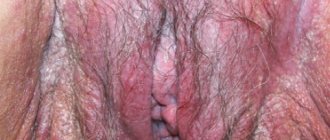White discharge is normal
Normally, natural vaginal discharge is light, transparent or slightly yellowish, not abundant and without an unpleasant odor. The main cause of white discharge in women is the secretion of glands that are located in the vulva and uterus. By the middle of the menstrual cycle, the discharge becomes as transparent as possible, it stretches noticeably and can leave marks on the underwear. Also, an increase in leucorrhoea is observed shortly before menstruation. Before it, white discharge in women becomes more liquid. It is recommended to use daily bags, which instantly absorb secretions and prevent the appearance of odor. Thin daily pads are also suitable for use at the end of menstruation, when many women produce small amounts of blood.
Causes of discharge at different ages
Pathological secretion occurs in girls of any age. The main reasons are weakened immunity, frequent use of antibiotics, genital and general infections, allergies (sometimes provokes atopic vulvovaginitis), diabetes mellitus (often accompanied by fungal vulvovaginitis), helminthic infestation, foreign body.
Mucous discharge, sometimes bloody, occurs in newborn babies. Their appearance is usually associated with a reaction to an increase in the level of maternal hormones entering their body. This anomaly does not require treatment and is not dangerous, but you need to visit a doctor to rule out pathology.
Read more Testosterone drugs for menopausal women
Menstruation usually begins at the age of 13-15, so the nature of the discharge, especially its volume, changes. When the secretion is produced in large quantities, it acquires a faint sour aroma, while the girl feels well, and there are no sores or redness on the genitals. This usually indicates normal sexual development of the child.
Brown discharge usually occurs before menstruation and lasts for several days. If after menstruation the secretion becomes normal, then the teenage girl is healthy. Brown secretion is secreted for a long time, regardless of the cycle - there is reason to suspect the development of an inflammatory process.
White
In most cases, white discharge in girls is quite normal if there are no associated symptoms. However, if there is a white secretion of a cheesy consistency on the child’s underpants, candidiasis cannot be ruled out, even when the baby is only a few months old or 4-6 years old. This fungal disease occurs with a general weakening of the immune system, during antibiotic therapy, and is transmitted from mother to daughter during childbirth.
Yellow or yellow-green
Dark or light greenish discharge in girls of any age - at 2 years old, at 9, and at 13 years old - is a sign of the development of a pathological process that cannot be ignored.
Yellowish discharge does not always act as a symptom. In girls aged 11-13 years (sometimes slightly younger or older than 10-12 years old), they say that hormonal changes are beginning. There is no need to worry when the yellow discharge is not accompanied by discomfort and other signs of the disease. If the girl is 5-7 years old or younger, a change in the color of the secretion is accompanied by other symptoms, this is a reason to suspect:
- diaper rash;
- irritation from synthetic underwear;
- ingress of foreign objects;
- reaction to hygiene products;
- helminthic infestation;
- dirt getting into the vagina;
- violation of child hygiene rules.
Purulent
If a child’s vaginal secretion contains purulent inclusions, this is always a symptom of a disease. The cause may be infection, inflammation in the uterus and/or ovaries, or colpitis. At the first sign of any of these diseases, you should immediately consult a doctor. Otherwise, the pathological process will lead to the development of complications or become chronic.
Purulent discharge and pain in the lower abdomen may be symptoms of an inflammatory process in the uterus or ovaries
With and without scent
Normally, girls' discharge should be odorless; the presence of a subtle sour aroma is allowed during puberty, about a year before the onset of menstruation. An intense foul odor often indicates that a foreign object has entered the vagina. An unpleasant fishy odor combined with greenish discharge is a sign of bacterial vaginosis.
A sharp, unpleasant odor of vaginal secretions may indicate the development of an infectious disease. If it is intense, accompanied by copious thick discharge that has an unnatural bright color, admixtures of blood and/or pus, this indicates a serious pathology caused by infection. You need to urgently consult a doctor.
White discharge due to women's health problems
Liquid white vaginal discharge is not always normal. If their number increases, a sharp unpleasant odor and other pathological symptoms appear, the woman should consult a doctor and undergo additional examination.
Indications for specialist consultation:
- copious foamy discharge with an unpleasant odor;
- itching and burning in the intimate area;
- swelling of the external genitalia;
- redness of the vulva;
- painful urination and pain during intimate contacts.
Abundant foamy discharge with an unpleasant odor and accompanying symptoms may indicate the development of diseases of the genitourinary organs.
The period from the moment of puberty of a girl until the decline of reproductive function is necessarily accompanied by secretion from the vagina. The most commonly observed mucous discharge in women is snot, which under certain conditions is considered normal. But disorders that require therapy cannot be ruled out.
Characteristics of normal discharge in women
The release of a substance from the genital tract can be attributed to a cleansing mechanism that removes “waste materials” from the reproductive organs. The composition of leucorrhoea is:
- Dead cells that are spontaneously rejected by the uterus and excreted through the fallopian tubes and vagina.
- Non-inflammatory effusion that accumulates in the blood and lymphatic vessels.
- Various microorganisms that form microflora, but have become obsolete.
- Moisturizing, enveloping and protecting mucus produced by the cervix and “washing” the uterine cavities (cervical fluid).
Vaginal discharge like snot should not be a cause for concern if it:
- transparent (colorless);
- have whitish veins;
- leave a yellow mark on the panty liner after drying;
- odorless or slightly sour;
- do not cause discomfort (burning, itching, pain);
- viscous, lump-free and dense clots of pus;
- several hours or days are noted.
Based on the norm established by gynecologists, the volume of secretions of clear mucus without third-party aromas should not exceed 4 ml per day (one teaspoon). If the threshold is slightly exceeded, but no changes in other parameters are observed, then this phenomenon can be attributed to the peculiarities of the functioning of the reproductive organs.
The photo shows normal female mucus discharge:
White mucus discharge Discharge like snot Clear discharge White mucous discharge
The birth of a daughter is always a pleasant and joyful event. The first tooth, the first step, the first cold, the first fall - each of these events will forever remain in the hearts of passionately loving mothers and fathers. Being inexperienced, young parents are wary of any previously unknown changes that occur in their daughter’s body. For example, the presence of vaginal discharge (leucorrhoea) in a girl is quite normal, provided that it is transparent or whitish and mucous, as during puberty, or bloody, which is observed in the first week after birth. Normally, discharge from the genital tract should not have an unpleasant odor or cause concern to the child.
As a rule, the appearance of yellow vaginal discharge in a girl, regardless of the child’s age, is very frightening for parents who are trying their best to protect their child from various infections and diseases. Finding out the cause of yellow discharge in a girl is possible only with a comprehensive assessment of the child’s health, collecting anamnesis and conducting certain laboratory tests.
Puberty is a possible reason for the appearance of yellow discharge in a girl.
The appearance of yellowish discharge in a girl does not always indicate a pathological process. In some cases, yellowish discharge from the genital tract is observed in teenage girls who have reached puberty. A cause for concern is discharge that has acquired a grayish or greenish color, has become thicker and has the smell of rotten fish. All these signs indicate the presence of vaginosis, which is most typical for girls aged 11-15 years. Bacterial vaginosis is a condition in which the microflora in the vagina is disrupted. In this case, the cause of the disease may be frequent acute respiratory infections, hormonal imbalance in the body, poor nutrition, poor personal hygiene, metabolic disorders (obesity, diabetes), etc.
The girl has yellow discharge. Perhaps it is vulvovaginitis.
As a rule, the appearance of traces of yellow discharge with an unpleasant odor on a girl’s panties indicates an inflammatory process. If such discharge is accompanied by redness of the vaginal mucous membranes, itching and pain when urinating, then we are talking about vulvovaginitis - an infectious and inflammatory disease.
Most often, girls under 8 years of age are affected, which is associated with the characteristics of the vaginal microflora in childhood. At a young age, before the onset of puberty, there are no lactic acid bacteria in the microflora of a girl’s vagina, the main function of which is to protect against infection. The absence of lactobacilli in combination with a weakened immune system or a history of allergies are favorable conditions for the growth and reproduction of pathogenic microorganisms. Vulvovaginitis with the appearance of yellow discharge in a girl is usually caused by streptococcus, enterococcus, fungal microorganisms, staphylococcus, and E. coli.
The main reasons for the development of vulvovaginitis and the occurrence of yellow discharge in girls:
1. Infection:
- getting dirt and infection into the vagina (unwashed hands, sitting on the floor without underwear, swimming in a dirty pond);
- helminthic infestations, namely pinworms that crawl into the vagina (discharge is accompanied by itching in the perineum and around the anus, which intensifies at night).
2. Exposure to chemicals:
- severe allergic reaction to soap, cream or shampoo used in daily care.
3. Mechanical damage to the vaginal mucosa:
- inflammation in the vagina, as a result of irritation and diaper rash from swaddling;
- a foreign body stuck in the vagina, which the child accidentally inserted into the vagina (in this case, the discharge acquires a dark yellow tint and a pronounced unpleasant odor).
The girl has yellow vaginal discharge. What to do?
The first thing to do if a girl has yellow discharge is to visit a pediatric gynecologist. Only a specialist can accurately determine the cause of the disease, conduct all the necessary studies and prescribe effective treatment.
Some sources of information posted on the Internet, if a girl has yellow discharge, strongly recommend waiting a week, in the hope that the symptoms of the disease will disappear on their own. Under no circumstances should this be done! At the first signs of illness, you should immediately consult a doctor.
Do not self-medicate under any circumstances! The use of herbal baths or other home remedies does not eliminate the cause of yellow discharge in girls, but only erases the symptoms of the disease, thereby complicating the diagnostic process.
Depending on the suspected cause of yellow discharge in a girl, the pediatric gynecologist prescribes the appropriate research method:
- if there is a suspicion of the presence of a foreign object in the vagina, a vaginoscopy is performed;
- To determine the causative agent of a urogenital infection (gonorrhea, chlamydia, trichomoniasis, etc.), its sensitivity to a particular antibiotic, a smear and culture of the vaginal microflora are performed.
The girl has yellow discharge. How to treat?
The treatment plan for vulvovaginitis is determined individually after assessing the results of the studies. Symptomatic therapy includes the use of powders and baths to reduce itching and redness. Elimination of pathogenic microorganisms is carried out by prescribing antibiotic therapy, as well as using special suppositories and ointments for sanitizing the vagina. To prevent a recurrence of the inflammatory process, when girls have yellow discharge, drugs are prescribed to strengthen the immune system, namely, complexes of vitamins and minerals. To restore the vaginal microflora, eubiotics are used - preparations containing bifidobacteria and lactobacilli.
The girl has yellow discharge. How often to visit a pediatric gynecologist?
After the necessary treatment has been prescribed, the frequency of visits to the pediatric gynecologist is as follows:
- on days 3-7 during treatment;
- on the 30th day after the end of treatment;
- Once a year to prevent the occurrence of diseases.
Remember, timely diagnosis and subsequent treatment of infectious and inflammatory diseases of the genital tract in girls will help to avoid serious complications, including chronic inflammatory diseases of the appendages - one of the main causes of female infertility.
Physiological causes of discharge clear as snot
The presence of very abundant mucous discharge in girls is not normal. This is due to the fact that before reaching puberty, the egg is in the stage of formation and active development, which means that the hormone estrogen is just preparing for production.
This substance is a harbinger of the formation of the menstrual cycle. After the girl has reproductively “formed” and become a girl, she will be constantly present, changing intensity and saturation depending on the phases of the cycle.
Mucus discharge after and before menstruation
The appearance and volume of discharge depends on the predominance of a particular hormone in a particular phase of the cycle. Such secretion is allowed before and after menstruation.
- At the beginning of the menstrual cycle after monthly blood loss, most girls notice viscous sticky mucus on the pad, sometimes mixed with blood, so a pink or light red tint is possible. Heavy mucous discharge after a scanty period sometimes means pregnancy.
- In the middle of the cycle, ovulation occurs, which is accompanied by a maximum amount of estrogen. This hormone makes the discharge abundant and also reduces its viscosity to facilitate the path of sperm to the egg, while at the same time it can pull the lower abdomen. However, not all women have a thin mucus consistency at this time.
- Towards the end of the menstrual cycle, the hormonal background stabilizes, there is less and less secretion, it becomes transparent, sometimes slightly white, and the consistency resembles a cream or even jellied meat. A few days before your period, the secretion may appear again, so discharge like clear mucus stretching between the fingers is not excluded.
Probability of conception and pregnancy
If there is a delay, and instead of menstruation there is a discharge very similar to snot, then pregnancy cannot be ruled out. The level of the hormone prolactin increases in the body, causing thicker secretion, which protects the woman’s reproductive system and fetus from harmful bacteria and infections. At this time, brown or pink mucus from the vagina is also possible, indicating the fixation of the fertilized egg in the uterine cavity.
In the second trimester (from 14 to 27 weeks), a small amount of such discharge indicates a normal course of the gestation period. When their volume increases, they flow like water, which means there is a threat of premature birth, especially if blood clots are present.
What is discharge in girls and what is its norm?
The mucus or liquid secreted from the vagina of a girl, as well as an adult woman, is called sexual secretion, vaginal discharge and leucorrhoea.
From a physiological point of view, normal discharge in a girl, regardless of age, differs in the following characteristics:
- have an almost uniform mucous consistency (not watery);
- almost transparent;
- light, slightly white;
- odorless, slightly sour due to the vaginal environment;
- not accompanied by unpleasant sensations;
- indicated in small quantities.
The presence of such marks on a child’s underpants should not cause concern. The reproductive system of any person will develop gradually, and these changes are inevitable. It is impossible to say exactly what time discharge begins in girls. Heredity, body characteristics, and other related factors are taken into account.
It is generally accepted that girls should have no discharge until puberty. But the onset of puberty does not have a clear framework and depends on many factors.
In a 10-12 year old girl, discharge on her panties may not indicate abnormalities if their appearance corresponds to the norm. Perhaps the child began puberty much earlier, and this is how the body prepares for serious restructuring and menarche. It wouldn’t hurt to contact a gynecologist to be on the safe side and get tested, but panic will be inappropriate, since at this time the child reacts very sharply to the world around him and may misperceive the concerns of his father and mother.
Parents almost always sound the alarm, worrying about discharge in newborn girls, not knowing what it means, and attribute this process to a pathological phenomenon. But vaginal secretions that are light in color and have a mucous consistency are considered normal.
In some situations, there is very little blood in the mucus. There is no need to worry, because from a medical point of view, this phenomenon is safe and is considered the so-called sexual crisis of newborns. Find out about this in one of our articles.
Characteristics and causes of pathological discharge
Often, mucus secretion in women that does not correspond to the norm is caused by the following problems:
- infection in the vagina;
- chronic fungal diseases;
- consequences of the operation;
- incorrectly selected hormonal therapy;
- decreased immunity;
- changes in vaginal microflora;
- pathological processes in the reproductive system.
In each individual case, in addition to the secreted mucus, the woman will note additional symptoms that cause discomfort. But in the early stages of diseases it may be absent, and then the first signal will be precisely modified secretion.
A direct indication of health problems is vaginal discharge, which has the following features:
- rich color (yellow, green, brown, scarlet);
- long duration (more than three or four days are observed);
- heterogeneous consistency (lumps, blood clots, pieces of pus);
- a sharp increase in temperature;
- general malaise;
- rashes on the external genitalia;
- systematic burning and itching in the perineal area;
- pain in the lower back and abdomen;
- foamy or curdled consistency;
- discomfort while washing.
The photo shows examples of pathological secretions:
Bloody mucus Orange discharge Bloody discharge Yellow discharge
Constant discharge in significant quantities, even without discomfort, indicates disturbances in the microflora of a woman’s vagina. Without timely diagnosis and properly selected treatment, protective functions are reduced, creating favorable conditions for various infectious and fungal diseases.
Causes of green and yellow discharge
In this case, bacterial vulvovaginitis is most often diagnosed. If a 4-year-old girl has yellow-green discharge, there is a specific smell of fish, and the external genitalia are red, this indicates the presence of this disease. Another symptom of bacterial vulvovaginitis is itching. The child constantly scratches the labia area and is almost always capricious during water procedures.
Yellow discharge in a 4 year old girl may indicate:
- Worm infestation.
- Penetration of dirt into the vagina.
- Unsuitable product for intimate hygiene.
- The presence of a foreign object in the vagina.
- Skin irritation caused by wearing synthetic underwear.
In girls aged 4 years, yellow discharge is not uncommon. This is due to the fact that up to 8 years of age there are no lactobacilli in the vaginal microflora, whose task is to destroy pathogenic microorganisms.
But green discharge in girls at 4 years old (or at 5, 6, etc.) clearly indicates the presence of inflammation. In this case, you need to contact a medical facility as soon as possible.
Snot-like discharge based on shade
No less than the volume and consistency of the secretion, its color also indicates the processes occurring in the woman’s genital organs.
Transparent with green particles
The discharge indicates the presence of an advanced sexually transmitted infection. Accompanied by a characteristic putrid odor, burning and itching in the perineal area. Sometimes they are supplemented by pain in the lower abdomen and allergic rashes in the armpits.
White
White, odorless mucous discharge is not caused by diseases of the reproductive system, and may well be a physiological norm if we are talking about the following:
- the beginning of the ovaries (puberty);
- a specific segment of the monthly cycle;
- discharge during sexual arousal and intercourse;
- suffered stress;
- sudden climate change;
- reaction to an intimate hygiene product;
- use of HRT or OK;
- pregnancy;
- preparing the body for childbirth;
- breastfeeding;
- menopause
The appearance of a rich white color, a cheesy consistency and an unpleasant odor indicates thrush. A woman in this condition feels itching and burning, and swelling of the external genital organs is also possible.
Causes of white discharge
To distinguish a physiological secretion from a pathological one, you need to pay attention to its smell and consistency. If a 4-year-old girl's white discharge looks like cottage cheese, this indicates the presence of candidiasis.
The causative agent of thrush is a fungus of the genus Candida; it is easily transmitted from mother to child during childbirth. In addition, the initiation of the development of pathology can occur against the background of a weakening of the body’s defenses or during treatment with antibiotics.
If a 4-year-old girl has white discharge, it is necessary to make an appointment for the baby to see a doctor as soon as possible. In addition, it is necessary to exclude the consumption of baked goods and confectionery products. These products create a favorable environment for fungal growth.
Causes of mucus secretion in women
What does this mean? Natural mucous discharge from the vagina occurs for various reasons:
- The secretion of mucus is provoked when excited.
- Experiencing any stress.
- Abrupt climate change.
- Treatment with hormone-containing medications.
- Allergy of local or general manifestation.
- Improper intimate hygiene.
- Hormonal fluctuations during the cycle. Before and after menstruation, the amount and structure of mucus changes significantly.
- A pregnancy condition that increases the amount of estrogen in the body, which affects the quantitative and qualitative composition of discharge.
Brown discharge in girls
They talk about the formation of the menstrual cycle and the imminent onset of menstruation. If you already have your period, then such discharge may occur 2 days before and after menstruation. In the middle of the cycle due to sudden hormonal surges.
But if they continue for four days or more, you should consult a doctor. This may indicate hormonal imbalances, trauma, a foreign body, or an inflammatory process in the reproductive organs.
Leucorrhoea due to inflammation of the uterus and appendages most often occurs in adolescents who are sexually active. In girls aged 6 years, adnexitis is rare and, as a rule, is combined with acute appendicitis or other surgical pathology: cholecystitis, pancreatitis.
Clear vaginal discharge
If the mucus has a transparent structure, without emitting a pungent odor or causing discomfort, then this is simply proof of the proper functioning of the reproductive system, i.e. ovaries. Up to 2 ml of such secretion can be released per day, while a slightly whitish tint does not indicate pathology. This is simply the process of cleansing the vagina.
The volume and structure of discharge changes according to the phases of the menstrual cycle:
- From 1 to 5-7 days – the period of menstruation. First, spotting pink or brown secretions appear; on days 2-4 they include the maximum volume of blood in the form of lumps or clots; on days 5-7 they again decrease to spotting.
- From 5-7 to 13-14 days is the period of egg maturation. Copious mucus is not secreted at this time - only about 2 ml of watery, mucous or thick particles with lumps. Don't worry if the color changes from clear white to yellowish.
- Day 14-15 is the time of ovulation. Estrogen reaches its maximum level, so mucus comes out up to 4 ml. Its structure is stretchy, but sometimes it can be watery, and often even sticky. The hue during this period is the most saturated.
- Days 16-28 – the period before menstruation. The reproductive system calms down a little - there is less discharge, but just before the end of the cycle a sudden surge is possible due to an increase in the amount of hormones.
Sign of the disease
The smell and color of the discharge, similar to snot, changes when inflammatory processes occur in the body after surgery, as a result of decreased immunity, hypothermia, disruption of the vaginal microflora due to taking antibiotics. The peculiarity of pathological discharge is that it appears without any connection with the processes of the cycle and continues after menstruation, when the mucus should be the thickest and produced in an insignificant volume.
Also, discharge in the form of snot, which has an unpleasant odor, is colored yellow, green or gray, is foamy, abundant, and cheesy, indicates diseases of the genitourinary system, including those transmitted through sexual contact.
These include:
- Ureaplasmosis or mycoplasmosis;
- Genital herpes is a snot-like, watery discharge accompanied by the formation of painful blisters on the surface of the external genitalia;
- Chlamydia - clear or white discharge in the form of snot in large quantities with accompanying symptoms of the disease;
- Gardnerellosis - copious, mucous, gray discharge with an unpleasant fishy odor;
- Vaginal candidiasis - thick mucous discharge in large quantities in the form of curd flakes with a characteristic sour odor;
- Gonorrhea - abundant, mucous, green or yellow discharge, which is caused by an admixture of pus;
- Trichomoniasis is a profuse mucous discharge in the form of foamy snot, colored yellow or green.
- Vulvovaginitis, cervicitis, endometritis, salpingoophoritis - all these are inflammatory diseases of the internal and external genital organs, the manifestation of which is the presence of copious foul mucous discharge of yellow or green color.
Bloody discharge
Discharge in women, like snot with blood, indicates the appearance of a source of bleeding in the genitals. Most often, this is minor damage to the vasculature of the uterus and its cervix, localized in the mucous layer. It does not yet lead to the development of full-fledged bleeding not associated with menstruation.
The causes of discharge of this nature can be erosion or cancer of the cervix, tumor processes of the uterus (submucous myomas, fibroids), etc. In any case, the development of just such a symptom is a good reason for an urgent visit to a gynecologist. In a pregnant woman in the early stages, the appearance of vaginal discharge of this nature usually indicates a potential threat of spontaneous abortion.
In the period after 22-25 weeks of pregnancy and later, an admixture of blood in the mucous secretion may lead the doctor to think about the threat of premature placental abruption or its possible previa (placental tissue is connected to the internal cervical os - a variant of pathology).
Diagnostics of the child's body
Diagnosis of diseases accompanied by pathological discharge from the genital organs is carried out by a pediatric gynecologist. This doctor prescribes a number of studies and tests:
- general blood analysis;
- a vaginal smear to identify the bacteria that caused the inflammation;
- Analysis of urine;
- stool analysis to determine dysbacteriosis and worms;
- examination of the genitals for the presence of a foreign object;
- blood for hormones;
- PCR, which detects the type of pathogen and the presence of antibodies to these agents in the blood.
Read more When to place an IUD during menstruation
To clarify the causes of pathology
When is it considered normal?
Discharge that occurs after sexual intercourse does not belong to deviations from the norm. For example, the normal function of the reproductive system may have the following features:
- Clear or slightly white clots appear within 1-4 hours after sexual intercourse without using a condom.
- Liquid, abundant white sputum is released in the morning and is evidence of evening or nighttime contact without the use of barrier contraception.
- Scanty white creamy discharge that occurs as a response to sexual intercourse with a condom is also normal.
Quite often, women experience discharge with a brownish tint, similar in consistency to snot. This is a sign of the presence, in addition to mucus, of bloody impurities. They may appear after taking hormonal contraceptives. If they are not accompanied by pain, discomfort, unpleasant odor and itching, then this should not cause concern to a woman, as it is considered normal.
If the discharge is mucous and has a brown tint, in addition, there is an unpleasant, pungent odor, then you should consult a doctor, who can pronounce a verdict of chronic endometritis.
When is a doctor needed?
If vaginal discharge in the form of clear mucus is not accompanied by pathological symptoms such as an unpleasant odor, impurities of pus or blood, increased body temperature, pain and discomfort, then this is considered a variant of the physiological norm.
The following signs are reasons to contact a medical specialist:
- Increased body temperature;
- Aching and cutting sensations in the perineum;
- Discomfort and pain during intimacy;
- Menstrual dysfunction;
- Frequent and painful urge to urinate;
- Redness, rash and itching on the mucous membrane of the external genitalia;
- Drawing pain in the lumbar region.
If one sign or a combination of them appears, the woman is recommended to immediately undergo a medical examination. The choice of diagnostic and treatment tactics is carried out by a specialist gynecologist or dermatovenerologist. If an infectious disease of a bacterial nature is detected, the patient is prescribed a course of antibacterial therapy with broad-spectrum drugs. If pathological discharge is caused by the genital herpes virus, then this problem can be solved with the help of antiviral agents. A striking example is the drug Acyclovir.
How to treat?
Normal healthy discharge should not be a concern, you just need to maintain the required level of personal hygiene. You should wash it twice a day with plain water, change your underwear every day, preferably it should be made from natural fabrics. If you have to use panty liners, it is advisable to choose ones without various flavors and fragrances, as they can provoke microflora disturbances.
If the discharge increases in volume or acquires an unhealthy hue or smell, you should consult a gynecologist as soon as possible. Treatment will depend on the disease that provoked the changes in the secretion. The main thing is not to delay contacting a specialist; some diseases can be extremely dangerous, they lead to infertility and can even threaten a woman’s health.
Prevention
Pathological mucous clear discharge in women is treated depending on what is causing the problem. For example, yeast infections are usually treated with antifungal medications, which are injected into the vagina in the form of a gel or cream. Bacterial vaginosis is treated with antibiotic tablets or ointments.
Most vaginal infections and other diseases of the internal genital organs can be prevented with simple preventive measures:
- Practice good personal hygiene and regularly wash your outer labia with mild soap and warm water.
- Whenever possible, limit the use of scented soaps and intimate hygiene gels.
- Wear 100% cotton underwear and avoid overly tight clothing.
- Always use a condom during sexual intercourse, and be sure to wash yourself after sex.
The female body is designed in such a way that, in addition to monthly menstruation, clear vaginal discharge is also observed. Often, such leucorrhoea is the absolute norm and should not be a cause for concern, especially if all preventive measures are followed. But any changes should force the woman to consult a doctor at least for a consultation. Be healthy!
“>
Preventive actions
Simple preventive measures will help keep the girl healthy and avoid many problems in the future. The main elements of prevention are regular visits to the pediatric gynecologist and compliance with the rules of personal hygiene for the child. The latter require close attention from parents from the first days of a little girl’s life:
- underwear should be made from fabrics of natural origin with a minimum content of synthetic fibers;
- do not use rough washcloths and sponges for intimate hygiene to avoid mechanical damage;
- teach the girl to wash her genitals correctly, in particular, explain that all actions should be carried out in the direction from front to back;
- select hypoallergenic products for intimate hygiene;
- for washing, use warm water, if possible boiled, use potassium permanganate solution and herbal decoctions only during treatment, no longer than the course prescribed by the doctor;
- the child must use his own towel, which must always be clean;
- Hygienic procedures must be carried out twice a day - morning and evening.
Read more Vpg 1 2 igm











